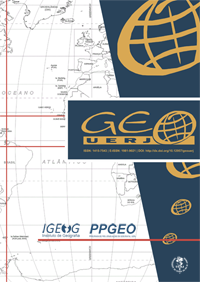COMPARISON OF RESULTS OF THE SUPERVISED CLASSIFICATION OF SOIL COVERAGE BY MAXIMUM LIKELIHOOD OF IMAGES LANDSAT-5 TM AND ALOS AVNIR-2
DOI:
https://doi.org/10.12957/geouerj.2016.19099Keywords:
Remote sensing, LANDSAT, ALOS, classification, Land Use, Supervised classification, Maximum likelihood.Abstract
doi: 10.12957/geouerj.2016.19099
Changes in land cover, especially in the tropics, has been occurring at an accelerated rate and with it the largest and most diverse rainforest in the world, the Amazon jungle or the Amazon Biome, also suffers from this process. At present study were compared results obtained from characterization of land cover by supervised classification by maximum likelihood using LANDSAT 5 TM and ALOS-2 AVNIR images. The study area chosen for this evaluation was the area of the Settlement Project Carlinda in Mato Grosso State, located on the so-called Legal Amazon. From the results it was observed that areas of each classes in the two images have similar values. The small variations should be presented due to the difference between the spatial resolutions of the images and the difference of the spectral bands regions involved in the analysis, especially the Green band. Analyzing the classes according spatial representation, in both images, the water bodies class was the smaller, followed by preserved vegetation class and wetland vegetation class. The class of anthropic vegetation / exposed soil was the most represented class in both classifications. Regarding the study area, it was observed that in the region there is a predominance of areas used in various human activities and gradual reduction of areas with preserved vegetation. This fact is diametrically opposite to what one would expect from an area in the Amazon, where, by the law need 80% of its territory be preserved.
Downloads
Downloads
Published
How to Cite
Issue
Section
License
The copyright of articles published in Geo UERJ belongs to their respective authors with rights to first publication conceded to the journal. Every time that the article is cited and reproduced in institutional repositories or personal and professional web pages the link to the journal web page must be provided Geo UERJ.

The articles are simultaneously licensed under theCreative Commons Atribuição-Não Comercial-Compartilha Igual 4.0 Internacional.


